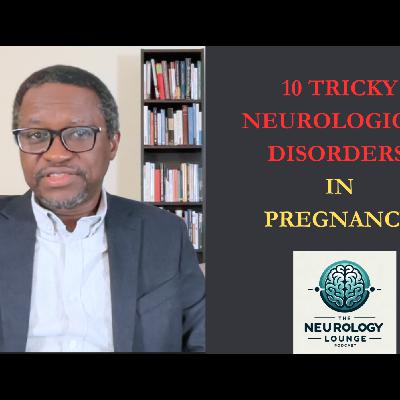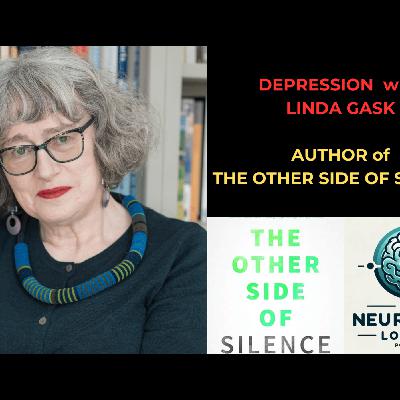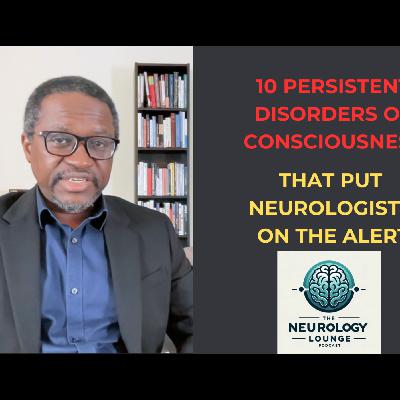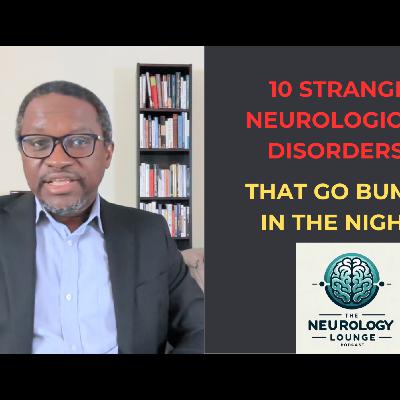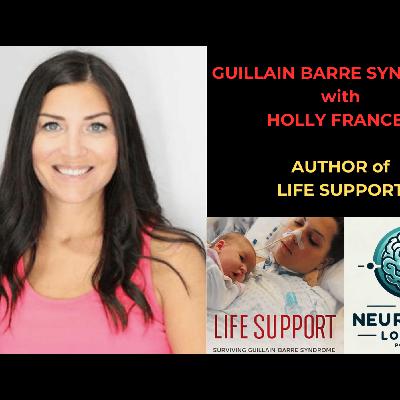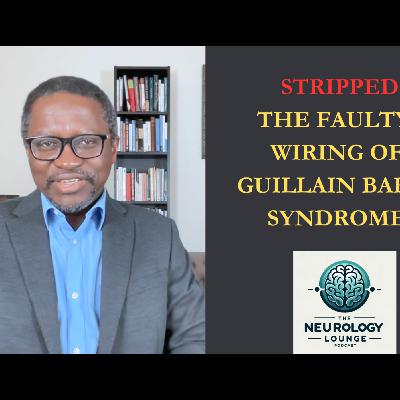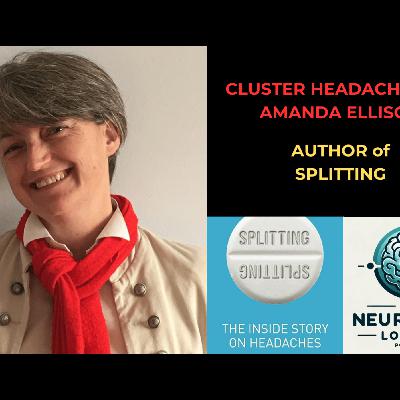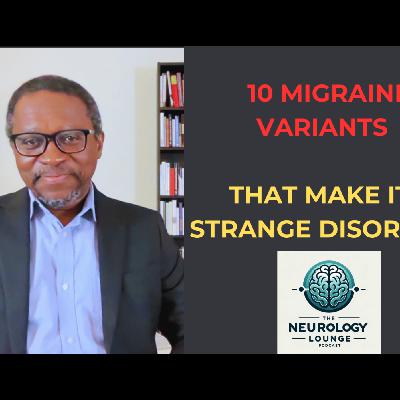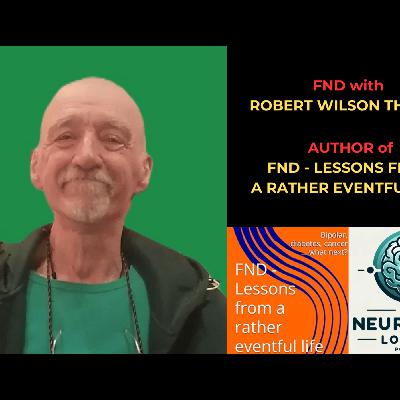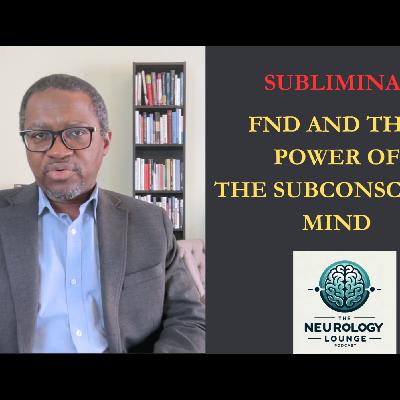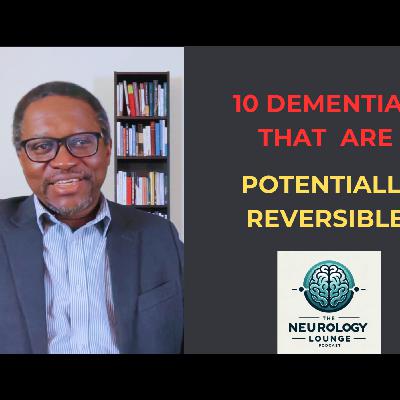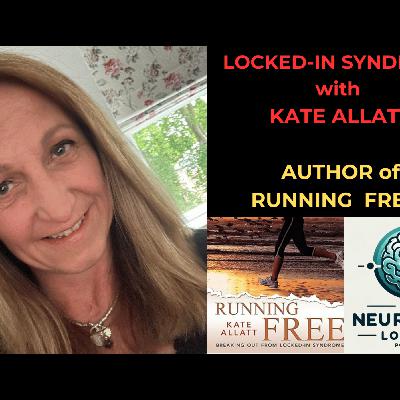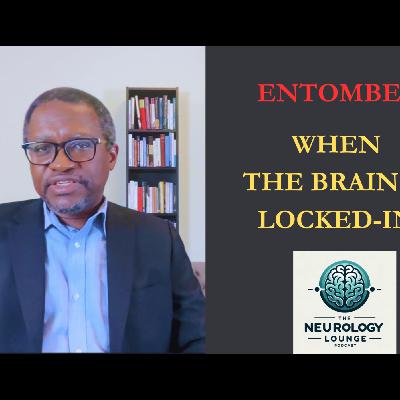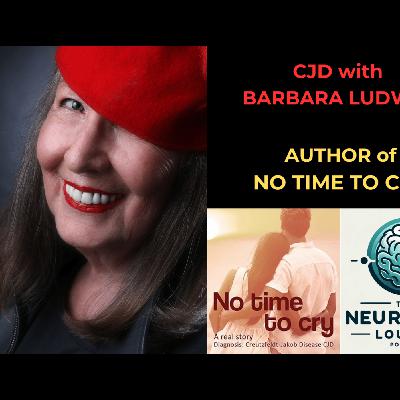Discover The Neurology Lounge
The Neurology Lounge

The Neurology Lounge
Author: Ibrahim Imam
Subscribed: 19Played: 144Subscribe
Share
© Ibrahim Imam
Description
This podcast explores the diverse perspectives of neurology. It consists of monologues and conversations with neurologists, neuroscientists, neuroscience journalists and neurology patients who have written accessible books on the brain and its disorders.
84 Episodes
Reverse
In this short podcast, I highlight 10 major neurological disorders that can afflict pregnant women.
Linda Gask joins me in this episode to explore her dual perspectives of depression as a sufferer, and as a psychiatrist. Emerita Professor of Primary Care Psychiatry, Linda chronicles her history of depression which first reared its head when she was in medical school, and dogged her career as a junior doctor and then as a consultant. Linda described the manifestations of her depression, from low mood and poor motivation to physical pain and suicidality. She also highlighted her co-morbid performance anxiety, obsessiveness, and ruminative thoughts. We also explored her biopsychosocial vulnerabilities to depression, such as a strong family history of mental illness, and the life events that trigger her breakdowns. The podcast also discussed Linda's double-edged experience of antidepressants, and of psychological therapies. She also highlighted the importance of having healthy relationships and being open about the disorder. Other themes of the conversation are the vulnerability of doctors, especially psychiatrists, to depression and suicide; the practical approaches to managing depression; and the inadequacies of current anti-depressant therapies.Linda has worked as an advisor to WHO and has been on the Board of the World Psychiatric Association. She co-founded the STORM suicide prevention training organisation, and she now serves as Vice-Chair of the Blide Trust, a mental health voluntary organisation. Her latest book is ‘Out of Her Mind: How We are Failing Women’s Mental Health and What Must Change’.
In this episode I take an exhaustive look at the diverse perspectives of depression, that pervasive mood disorder that afflicts far too many people. I explore its gradual onset and chronic, often life-long course, and highlight the overwhelming features of depression, from low mood and poor appetite to poor sleep and loss of interest in pleasurable activities. I also explore the less appreciated dimension of the pain of depression.I illustrate the lived experience of depression with such fascinating patient accounts as that of Sally Brampton titled Shoot the Damned Dog, of Lewis Wolpert titled Malignant Sadness, of Andrew Solomon titled The Noonday Demon, and of William Styron titled Darkness Visible. Significantly, the memoirs stress the difficulty people have in recognising that their low mood has crossed the threshold into depression.The interplay of familial and environmental risk factors of depression is also a major theme of the podcast which emphasised such critical provoking life events as divorce and loss of income. I also discussed the risk of suicide that may complicate depression, a theme that I explored by relying on the book When It is Darkest by psychologist and suicide expert Rory O’Connor.I also discuss the different treatment modalities of depression, from antidepressants and psychotherapy to somatic therapy, the long road to recovery, and the ever-present risk of treatment resistance and relapse. Other themes the podcast covers are the shame and stigma that accompany depression.The historical themes of the podcast highlight the insights of Abu Zayd Al Balkhi in depression and cognitive behaviour therapy, that roles played by Sigmund Freud and Joseph Breuer in establishing psychoanalysis, and that of Nathan Kline in the development of the first antidepressant.
This brief podcast reviews the top ten causes of persistent impairment of consciousness.
I am joined in this podcast by Joanne Hedger to discuss her lifelong experience of aphantasia, something she has written about in her memoir titled Aphantasia: Journeying Through Mind Blindness and Embracing Our Unique Neurodiversity with Passion and Purpose. Our conversation delved into how she discovered she had aphantasia when she alone was unable to understand a joke with friends in a camp site. We also explored the emotions this discovery evoked in her, from loneliness and regret to relief and understanding.Beyond her inability to imagine visually, Joanne also reflected on other lifelong characteristics, such as with dreaming and memory. Other themes we covered in the conversation are the history of our understanding of aphantasia, its acquired and familial causes, its impact on her perception of herself and on her relationships, and the advantages of having aphantasia.We also explored the strategies she has adopted to compensate, even before she knew she had aphantasia, from relying on lists and spreadsheets to taking a lot of photographs and notes. Joanne also highlighted practical recommendations for parents, teachers and students which included identifying aphantasia early, using memory aids, accepting it as a feature of normal neurodiversity, and making educational adaptations to accommodate it.Joanne spent her early years growing up on a dairy farm in south-east England where her fascination with nature began. After a corporate career in software consultancy, which spanned 25 years, several continents, and numerous bouts of stress and exhaustion, Joanne quit the rat race in 2017 to follow her passions for wildlife and photography. Despite being mind-blind and left-handed, Joane stressed that she is hugely creative and sees her own level of aphantasia as a quirky fascination, not a hindrance or a disability.Following graduation, she worked as a guide and later became the manager of a luxury bush camp in the Kafue National Park, Zambia, where she still freelances for a few months each year. She lives in the UK and, when she's not writing, she spends her time rewilding a small piece of ancient woodland, making handmade nature-inspired jewellery and taking photographs. You can find her on Facebook or visit her website, www.elementalretail.com
In this episode, I explore the fascinating phenomenon of aphantasia, the inability to imagine. I discuss the manifestations of the condition which primarily affects visual imagination, but which also affects the ability to imagine sounds, smells, tastes, touch, and even feelings. The podcast also illustrates how aphantasia influences recollection of memories, and how it impacts of education and career.I illustrate aphantasia with such fascinating memoirs as that of Charlotte Langlais, titled 'Aphantasia Club', and of Alan Kendle titled 'Discover the Fascinating World of Aphantasia'. These show the different ways by which people with aphantasia discover that they have the condition, and the emotions that accompany this knowledge.Importantly, the podcast also highlights how people with the condition adapt by using alternative strategies, and how they have found such advantages of aphantasia, from the better ability to remember facts and meditate to the lesser risk of reliving painful memories.The podcast also traces the history of our understanding of aphantasia, starting with Francis Galton who first described, to Adam Zeman who resuscitated its study. This theme also narrated how Zeman came to coin the name aphantasia. Also covered in the podcast is the epidemiology of the condition, its familial and acquired causes, and its associated features, from impaired facial recognition to difficulty recollecting dreams.
In this episode, I explore 10 disorders that manifest during sleep, or are considered sleep disorders. These range from the more familiar REM sleep behaviour disorder, to the lesser-known exploding head syndrome.
I am joined in this podcast by Holly Frances to discuss her experience of Guillain Barre syndrome as she narrated in her illness memoir titled Life Support: Surviving Guillain-Barre Syndrome. Holly is a mother in a blended family of five, and the face behind Holly After GBS on social media, where her recovery videos have inspired millions of people around the world. Our conversation traced Holly’s illness from onset with mild sensory symptoms through to complete paralysis within a short time. Importantly, she highlighted less appreciated symptoms of the disease that she experienced, particularly neck pain, a major early symptom that initially indicated a different diagnosis, and which exacerbated and spread as her illness progressed.Holly chronicled how her weakness progressed rather rapidly to complete paralysis and requirement for ventilation on the intensive care unit. We also discussed the spinal fluid analysis and electromyogram tests she had to confirm the clinical diagnosis of GBS, and the various treatments she received. Our conversation also detailed her long rehabilitation course, interspersed by relapses, and her long and slow journey to complete recovery. Significantly, Holly also explored the emotional and psychological burden that the illness placed on her, ranging from fear and anxiety to resentment and depression, and the uncertainty that plagued her mind regarding outcome. We also covered how her life and relationships changed on account of her experience of GBS, what the illness has taught her, and the advocacy work that is now the focus of her work.
In this episode, I delve into Guillain Barre syndrome, a relatively common neurological disorder. I discuss the clinical manifestations of the disease which range from fairly rapid weakness and sensory impairment to pain and breathing difficulty. I also detail the long road to recovery from the disease. The podcast also discusses the almost limitless triggers for GBS, from infections and vaccinations to trauma and childbirth. I also review the pathology of the disease, explaining how a wide range of antibodies target the fatty myelin covering of the nerves to reduce the efficiency of electrical nerve transmission. The podcast also highlights the investigations of GBS, particularly spinal fluid analysis and nerve conduction studies, and the treatment of the disease, which canter around immune modulating agents. I also chronicle the history of the terminology of GBS, following the work of the three French physicians, Georges Guillain, Jean Alexandre Barré, and André Strohl. I refer in this theme to the book 'Guillain-Barre Syndrome: From Diagnosis to Recovery', by Gareth Parry and Joel Steinberg.I illustrate the clinical aspects of GBS with such graphic patient memoirs as those of Carole Williams, titled 'Chaos in Body and Mind', of Meg Lumsden, titled 'Unknown', of Wenesday Ketron titled 'Geeyahn What?', of Scott Earle titled 'The Wave of Guillain Barre Syndrome', and of Robin Sheppard titled 'A Solitary Confinement'.
In this episode, Amanda Ellison joins me to explore the intersection of brain science and clinical practice as it relates to cluster headache. Amanda is a neuroscientist and physiologist, professor in the Psychology Department in Durham University and former Director of the Wolfson Research Institute for Health and Wellbeing, and she is interested in understanding how different brain regions communicate to create our behaviour and experience of the world around us. Our conversation on the history of the understanding of cluster headache used the monickers that have been applied over time as fulcrum, and these included migrainous neuralgia as proposed by Wilfred Harris, and Horton’s cephalalgia. We also explored the emergence of the name cluster headache, and how this coincided with the establishment of the International Headache Society.The podcast also exhaustively reviewed the biological mechanisms driving cluster headache with references to the emerging role of the hypocretin system in generating the disease, as well as its tendency to manifest in men and in smokers. We also delved into the clinical manifestations of the disease, with Amanda noting both the classical and the non-classical presentations. She also explored the circadian periodicity of the disease in the context of the role played by the suprachiasmatic nucleus and serotonin-melatonin pathway.The discussion also covered the acute treatment of alcohol especially with triptans and alcohol, a theme that reviewed the scientific contributions of Lisa Kudrow, the star of the television show Friends, and her father – both neuroscientists. We also looked at the history of the use of verapamil and lithium, the main prophylactic drugs of cluster headache. Amanda also explored the how coffee, chocolates and sex are biologically able to mitigate the severity of headaches, and the research into the place of deep brain stimulation of in the treatment of the disorder.
In this episode I explore the unbearable headache disorder that is cluster headache. The podcast revolves around the risk factors and causes of cluster headache, and the triggers for the attacks. It also reviews the characteristic features of the headache, and its typical accompanying cranial autonomic and behavioural symptoms. I illustrate the agonising manifestations of cluster headache using such patient illness memoirs as those of John Niven titled O Brother, Howard fast titled Being Red, and Rafael Haussler titled You Can’t See What I Feel. These narratives illustrate the characteristic features of cluster headache, from its abrupt onset, its diurnal pattern, its severity, and its tendency to recur in clusters.I also review the potential causes and familial tendency of cluster headache, its diverse triggers, and its impact on the lives of its sufferers. The podcast also covers the acute, transitional and preventative treatments of the disease which include the use of such interventions as triptans, oxygen, prednisolone, verapamil, and lithium.Using Mervyn Eadie’s enlightening book titled Headache Through the Centuries, I narrate the history of its scientific understanding noting the contributions of physicians from Nicholas Tulp in the 16th century, to Wilfred Harris and Bayard Horton in the 19th century.
In this short podcast, I count down 10 unusual variants of migraine which illustrate the challenging diversity of what is otherwise a common and well-recognised disease.
In this episode I am in conversation with Dr Robert Baloh to explore his insightful perspective of mass psychogenic illness specifically, and functional neurological disorders generally. Our conversation explored the general principles of medically unexplained symptoms and why most people have symptoms but only in some do these progress to become psychosomatic. We delved into the patterns, expectations and cultural beliefs that predispose to psychosomatic problems, highlighting such concepts as the placebo and nocebo effects.In our exploration of mass psychogenic illness, we reviewed such examples as the Belgian Coca Cola epidemic and Havana syndrome. This discussion looks at the factors that lead to the emergence and spread of mass psychogenic illness. Dr Baloh also outlines the mechanisms driving mass psychogenic illness, and the appropriate approaches to their assessment and management.Dr Baloh also discusses the history of hysteria with reference to such personalities as neurologist Jean-Martin Charcot and psychoanalysis founder Sigmund Freud. He also reviewed the history of such established disorders as multiple chemical hypersensitivity, myalgic encephalopathy and chronic fatigue syndrome. We discussed the uncertainties about the biology of these disorders, and the general ignorance of the medical fraternity and society at large about their nature.Dr Baloh is the author of 15 books, over 350 articles in peer-reviewed scientific journals, and over 100 book chapters. He also has an interest in the boundary between neurology and psychology, and in the history of neurology. Among his many honours, Dr Baloh received the Hallpike/Nylen Prize at the Bárány Society Meeting in Prague, Czechoslovakia in 1992 and had an international Dizziness and Balance Symposium in his honor at the 2014 American Academy of Neurology meeting in Philadelphia. His book Clinical Neurophysiology of the Vestibular System written with Vicente Honrubia, is currently in the fourth edition and is the standard in the field.
In this podcast, I explore the theme of mass hysteria or mass psychogenic illness. I discuss the triggers, the clinical manifestations, and the management.I use a global perspective and narrate examples of mass hysteria manifesting in different parts of the world. These included hysterical outbreaks of toxic gas anxiety in schools in Singapore, Hong Kong, and Bangladesh.Amongst the relatively contemporary conditions the podcast covers are the Havana syndrome, TikTok tics, and the epidemics of sleeping narrated by Suzanne O’Sullivan’s in her book titled The Sleeping Beauties.I also discuss the historical background of mass hysteria such as demonic possession in nunneries in Europe, and the mass dancing hysteria described by John Waller in his book titled The Dancing Plague.The podcast also covers the culture bound syndromes, such as Hwa-Byung - a Korean anger syndrome; Amok - bouts of mass murder in the Malay Peninsula; and Koro - genital retraction in Asia and Africa. Also included are cultural startle syndromes such as the Jumping French Canadians in Maine, and Miryiachit in Siberia.
I am joined in this episode by Robert Wilson Thomas to discuss his diverse perspectives of functional neurological disorder. This includes his experience as a patient, as narrated in his illness memoir FND: Lessons form a Rather Eventful Life, and his insights as an advocate for the disorder.Our discussion covered the triggers and vulnerabilities that led to Robert’s FND, a theme that went back to his childhood and which covered the role of emotions. We also reviewed the manifestations of his FND, from seizures to gait difficulty and falls. We also reviewed the convoluted path he took to getting a diagnosis, and how the disorder has progressed over the years.Also relevant is Robert’s exploration of the interventions that have been helpful, the unsatisfactory attitude of many in healthcare towards the disorder, and the prospects that research and better understanding are promising. The conversation also explored the importance of peer supports, and the prospects of the disease, and the impact of the disease on his career and relationships, and the stigma and myths that permeates society about FND.We also reviewed Robert’s advocacy work for FND. Robert retired from formal employment in 2017, and since mid-2018, he has been a Director, Co-chair and Legal Advisor to FND Hope International, the global charity dedicated to support and advocate on behalf of people with FND, and their families.Robert is Welsh by birth, but as he had lived in Ireland since 2001, he now tends to identify as Irish-Welsh although native Irish people still regard him as a ‘blow-in’. He is a practicing Buddhist, and has been a barrister since 1977, although his first degree was in chemical engineering. He describes himself as autistic, bipolar, diabetic, an alcoholic in recovery, vegetarian, and a cancer survivor. His latest book is titled A Box of Frogs: Dwells On and Delves into my Neurodivergent Nature.
In this podcast episode, I tackle the theme of functional neurological disorders, and I explore their almost endless types and diverse presentations. I particularly highlight functional seizures, noting their risk factors, their characteristic, even if diverse, presentations, the ways by which they may be distinguished from organic seizures. I also review functional movement disorders with a special emphasis on functional tremors. I also highlight the negative attitudes by which people with FND are treated by medical staff, who are themselves often poorly trained in the condition, and the tendency for FND to be misdiagnosed. I highlight the principles of communicating the diagnosis of FND and the often negative emotions the diagnosis elicits in many patients and their families on account of the stigma associated with it. I also review the challenges that doctors face with making a diagnosis of FND, and the management approach to the disorder. I illustrate functional neurological disorders with the books The Shaking Woman or A History of My Nerves by Siri Hustvedt, FiNDing Hope, by Jocelyn Bystrom, and FND Stories by Greg Rawlings and colleagues. The podcast also discussed the evolving scientific understanding of functional neurological disorders, and for this I cited the book by neurologist Suzanne O’Sullivan titled It’s All in Your Head. I also explore the fascinating history of the study of functional neurological disorders with reference to the role played by Jean-Martin Charcot, the acknowledged father of clinical neurology. In this context, I cited the book Medical Muses, written be Asti Hustvedt, which vividly captured the nature of hysteria, and the personalities of the famous hysterics that Charcot studied in Paris. This especially reviewed Blanche Wittman, Charcot’s most famous patient, and factors of her life that predisposed her to developing hysteria. I also used this text to highlight the less well-known positive contributions that Charcot made to the subject.
In this brief podcast, I explore 10 reversible neurological disorders that manifest as dementia. These range from HIV associated dementia and autoimmune encephalitis to Hashimoto encephalopathy and cerebral vasculitis.
I am joined by Kate Allatt to discuss her experience of, and advocacy for, locked-in state as she narrated in her book Running Free: Breaking out of Locked in Syndrome.Kate has an extraordinary journey of resilience after being ‘buried alive’, the result of a brainstem stroke when she was just 39. She described this as a condition where you can feel, think, hear and see completely normally but are unable to move a single muscle. She explored the transformation from being an active and passionate runner to being helpless and requiring help for every need.Kate chronicled the onset of her symptoms with a headache and slurred speech, and the subsequent progression of her symptoms with loss of consciousness that culminated in being completely locked-in. She also recalled the thoughts and emotions that dominated her mind in the subsequent stages of her illness.Our conversation also covered such concepts as the pessimism that permeates the attitude to the care of people in locked-in, the potential for completely recovery even the most extreme cases, the role of intense rehabilitation and determination in recovering from locked-in state, and the concept of neuroplasticity. She particularly highlighted how she brought her passionate attitude to running to her rehabilitation.Kate is an inspirational speaker and will also discuss the impact her advocacy and peer mentoring has made to thousands of families around the world. Running Free has been showcased on BBC Jeremy Vine, ITV This Morning, BBC Breakfast, The One Show, Women’s Hour, Newsnight, Loose Women, BBC Worldwide, India, South Africa, USA, South America etc. In addition, she founded a charity just three months from leaving hospital in 2011.
The theme of this podcast episode is the disabling condition of locked-in state. I discuss the typical causes that lead to locked-in state, particularly large strokes in the brainstem, and highlighting cervical dissection is an important mechanism for this. I also review its main clinical manifestations, noting how blinking and eye movements are often the only preserved motor functions, along with the emotional burden it imposes on patients and their families.I particularly highlight the uncertainty that dominates the early stages when the patient is aware, but family and healthcare personnel assume they are brain dead. Similarly harrowing are the discussions that flavour the management about continuing supportive treatment, and the fearful thoughts that dominate the victims’ experience, from the fear of dying from the condition, or being taken off life support. The podcast also explores the investigations of locked-in, and the acute care which typically requires ventilation and support of all vegetative functions.Other themes the podcast covers are the devices that enable people in locked-in state to communicate, the rehabilitation which is usually slow and long-term, and outcome which is often poor. I illustrate the issues I cover in the podcast with such memoirs as The Diving Bell and the Butterfly by Jean-Dominique Bauby, Locked-In by Richard Marsh, Blink by Sandra Nett, A Return to Duty by Clodagh Dunlop, In the Blink of an Eye by Mia Austin, and Ghost Boy by Martin Pistorius.
I am joined in this podcast by Barbara Ludwig to discuss her experience of CJD, the disease that her husband Jürgen died from, and which she narrated in her excellent memoir No Time To Cry. She explained how and why she was able to assume and convey her husband’s perspective of his illness experience, and how she used the title of the book to convey the importance of time in context of illness.Barbara explored Jürgen’s early symptoms with walking difficulty and anxiety, and how this progressed to disorientation and paranoid jealousy. She also captured the uncertainty that trailed his early diagnostic process as all investigations initially failed to confirm a diagnosis, and the uncertainty of how long he had to live. She discussed how he was initially thought to have multiple sclerosis and then a psychological disorder, and how the diagnosis of sporadic CJD was eventually confirmed by spinal fluid analysis, and later by post-mortem examination.Barbara also explored the burdensome care that Jürgen required, initially provided by her, but eventually by a nursing home where his terminal illness played out. We also discussed how she has coped since the death of Jurgen.Barbara Ludwig grew up in the western part of Berlin. She met Jürgen during her training in local government. They went to Australia after their wedding, and then to Lake Constance in the south of Germany near the border to the Swiss. She worked at the university there whilst Jürgen studied. They then moved to Munich where she worked for many years at the Goethe Institute as head of human resources. Today she writes Mallorca crime novels with passion, and she has been living for five years with her new partner in Bad Orb in the Spessart, near Frankfurt. Her latest book is 'Do You Love the Sea?'


